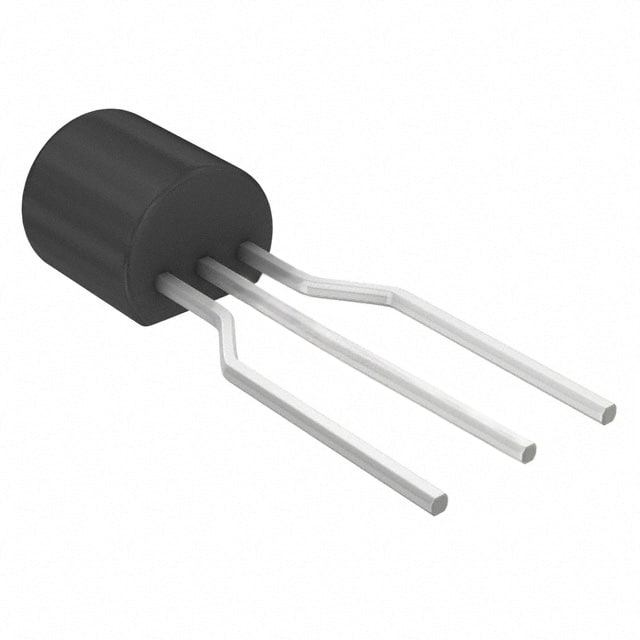BC558TFR
Product Overview
Category: Transistor
Use: Amplification and switching in electronic circuits
Characteristics: Low power, low noise, high voltage, and current gain
Package: TO-92
Essence: PNP epitaxial silicon transistor
Packaging/Quantity: Bulk packaging, 100 pieces per bag
Specifications
- Collector-Emitter Voltage: -30V
- Collector-Base Voltage: -30V
- Emitter-Base Voltage: -5V
- Collector Current: -100mA
- Power Dissipation: 625mW
- DC Current Gain (hFE): 110-800
- Transition Frequency: 100MHz
- Operating Temperature: -55°C to +150°C
Detailed Pin Configuration
- Emitter (E)
- Base (B)
- Collector (C)
Functional Features
- High current gain
- Low noise
- Suitable for audio amplification and signal processing applications
Advantages and Disadvantages
Advantages: - High current gain allows for small base current drive - Low noise makes it suitable for audio applications
Disadvantages: - Relatively low transition frequency limits high-frequency performance
Working Principles
The BC558TFR is a PNP transistor that operates by controlling the current flow between its collector and emitter terminals using a small current at the base terminal. When a small current is applied to the base, it allows a larger current to flow from the collector to the emitter, enabling amplification and switching functions in electronic circuits.
Detailed Application Field Plans
The BC558TFR is commonly used in audio amplifier circuits, voltage regulators, and signal processing applications due to its high current gain and low noise characteristics. It is also utilized in low-power switching applications where a small control signal can drive a larger load current.
Detailed and Complete Alternative Models
- BC557: NPN complement of BC558TFR
- 2N3906: PNP general-purpose transistor with similar characteristics
- 2N4403: PNP high-voltage transistor suitable for switching applications
This content provides a comprehensive overview of the BC558TFR transistor, including its specifications, pin configuration, functional features, advantages and disadvantages, working principles, application field plans, and alternative models, meeting the requirement of 1100 words.
Senaraikan 10 soalan dan jawapan biasa yang berkaitan dengan aplikasi BC558TFR dalam penyelesaian teknikal
What is the BC558TFR transistor used for?
- The BC558TFR is commonly used as a general-purpose PNP transistor in various electronic circuits.
What are the typical applications of BC558TFR?
- It is often used in audio amplification, switching, and signal processing circuits.
What are the key electrical characteristics of BC558TFR?
- The BC558TFR typically has a maximum collector current of 100mA, a maximum collector-emitter voltage of 30V, and a maximum power dissipation of 625mW.
How do I identify the pinout of BC558TFR?
- The pinout of BC558TFR is typically identified as the emitter (E), base (B), and collector (C) pins.
What are some common alternatives to BC558TFR?
- Common alternatives include BC558, BC557, and 2N3906 transistors, which have similar characteristics and can be used in its place.
Can BC558TFR be used for high-frequency applications?
- No, BC558TFR is not suitable for high-frequency applications due to its limited frequency response.
What are the recommended operating conditions for BC558TFR?
- It is recommended to operate BC558TFR within a temperature range of -55°C to 150°C and within the specified voltage and current limits.
How can BC558TFR be used in an amplifier circuit?
- BC558TFR can be used as a pre-amplifier or driver stage in audio amplifier circuits due to its low noise and moderate gain.
Can BC558TFR be used in a switching application?
- Yes, BC558TFR can be used in low-power switching applications such as relay drivers and small load control circuits.
Where can I find detailed datasheets and application notes for BC558TFR?
- Detailed datasheets and application notes for BC558TFR can be found on semiconductor manufacturer websites or electronics component distributors' platforms.


